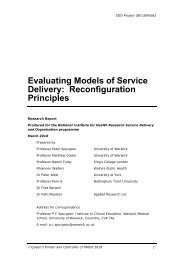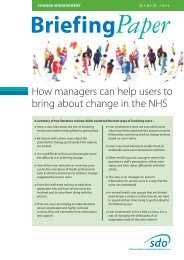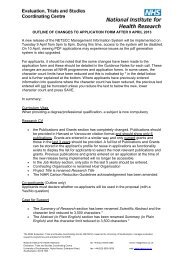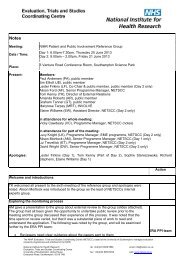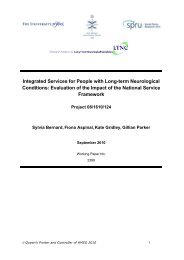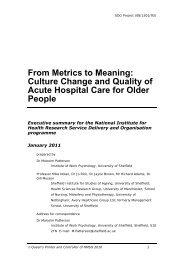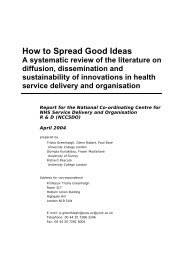Evaluation of IT modernisation in the NHS - NETSCC
Evaluation of IT modernisation in the NHS - NETSCC
Evaluation of IT modernisation in the NHS - NETSCC
Create successful ePaper yourself
Turn your PDF publications into a flip-book with our unique Google optimized e-Paper software.
Report to SDO for NCRS ProjectExecutive Summary3. MethodsThe study sample consisted <strong>of</strong> four <strong>NHS</strong> Acute Trusts. We used a comb<strong>in</strong>ation <strong>of</strong>qualitative and quantitative methods to address our objectives, mak<strong>in</strong>g comparisonsboth with<strong>in</strong> and between organisations. We used review methods to summariseexist<strong>in</strong>g evidence for objective 4.A qualitative researcher <strong>in</strong>terviewed a range <strong>of</strong> stakeholders <strong>in</strong>volved <strong>in</strong> implement<strong>in</strong>gand us<strong>in</strong>g <strong>IT</strong> applications, and addressed objectives 1 and 2. Two levels <strong>of</strong><strong>in</strong>terviews were conducted <strong>in</strong> three stages. Level 1 <strong>in</strong>terviews (objective 1), tookplace between July and October 2004 (stage A; n=24); and between February andApril 2006 (stage A; n=25). Level 2 <strong>in</strong>terviews (objective 2) took place betweenJanuary and October 2005 (n=44). Basel<strong>in</strong>e <strong>in</strong>formation was also collected for eachstudy site data.Level 1 <strong>in</strong>terviews <strong>in</strong>vestigated (a) <strong>the</strong> <strong>in</strong>fluence <strong>of</strong> contextual factors (historical orcurrent, facilitators or barriers) on <strong>the</strong> implementation <strong>of</strong> <strong>IT</strong> applications, and (b) <strong>the</strong>impact <strong>of</strong> recent Connect<strong>in</strong>g <strong>of</strong> Health policy changes on implementation processes.Level 2 <strong>in</strong>terviews <strong>in</strong>vestigated (a) experiences <strong>of</strong> <strong>NHS</strong> staff <strong>of</strong> specific <strong>IT</strong>applications (electronic test order<strong>in</strong>g and brows<strong>in</strong>g, or computerised physician orderentry, CPOE; electronic book<strong>in</strong>g; picture archiv<strong>in</strong>g and communication systems,PACS), and (b) <strong>the</strong> impact <strong>of</strong> <strong>the</strong>se applications on work<strong>in</strong>g practices. Interviewswere semi-structured on a one-to-one basis and took about one hour. Interviewswere taped and transcribed.We applied a modified grounded <strong>the</strong>ory analytic strategy to present an analysis <strong>of</strong>processes over time. This strategy comb<strong>in</strong>ed draw<strong>in</strong>g on <strong>the</strong> literature onorganisational change, and more user-centred sociological <strong>the</strong>ories <strong>of</strong> <strong>in</strong>novationadoption and implementation, with <strong>the</strong>mes emerg<strong>in</strong>g from <strong>the</strong> data.The quantitative research used a quasi-experimental ‘controlled before-and-after’design to quantify <strong>the</strong> effects <strong>of</strong> implement<strong>in</strong>g CPOE and PACS. Indicators werecompared between trusts that did and did not implement <strong>the</strong>se <strong>IT</strong> applications dur<strong>in</strong>g<strong>the</strong> period 2000 to 2005, tak<strong>in</strong>g <strong>in</strong>to account data for a basel<strong>in</strong>e period prior toimplement<strong>in</strong>g changes. Indicators were also compared with<strong>in</strong> Trusts betweenspecialties that did and did not implement <strong>the</strong> applications dur<strong>in</strong>g <strong>the</strong> same period.




